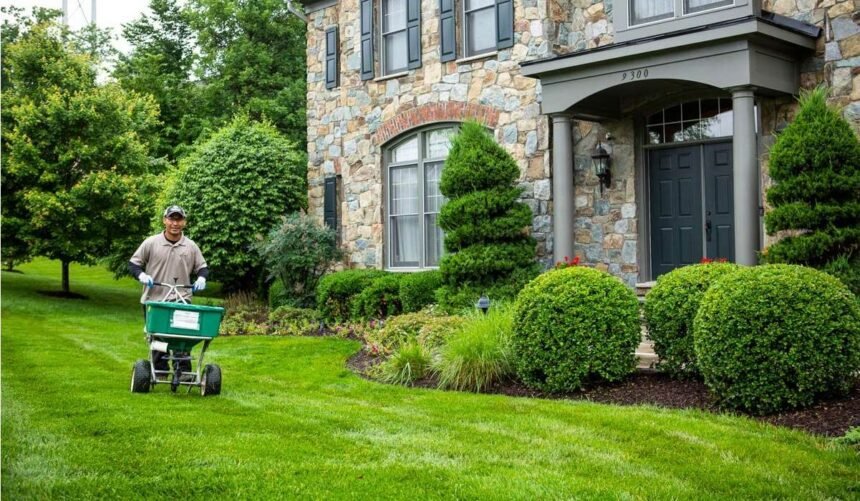Mulching is an easy, cost-effective way to improve your garden and lawn. It enhances plant health, conserves water, reduces weeds, and saves time. This blog covers the benefits of mulching, types of mulch, and tips to get started for a healthier, more sustainable garden.
What Exactly is Mulching?
At its core, mulching is the practice of covering the soil in your garden with a protective layer. This layer, known as mulch, can be made up of organic materials such as shredded leaves, wood chips, or straw, or inorganic materials like gravel or plastic.
Mulch serves multiple functions, such as regulating soil temperature, reducing evaporation, preventing weed growth, and enriching the soil as it breaks down (if organic).
Whether you’re a seasoned gardener or just starting out, mulching is an easy and effective way to give your lawn and plants an extra boost.
The Benefits of Mulching
Mulching is more than just an aesthetic enhancement for your garden. Its benefits extend to plant health, soil improvement, and environmental sustainability. Here’s why mulching should be at the top of your gardening to-do list.
1. Retains Soil Moisture
Mulch acts as a shield, reducing water evaporation from the soil. This means you’ll spend less time watering your garden and lower your water bill in the process. For gardeners in drought-prone areas, mulching can be a lifesaver for keeping plants hydrated.
2. Keeps Weeds at Bay
Tired of battling unwanted weeds? Mulch forms a barrier that blocks sunlight, making it difficult for weed seeds to germinate. By simply spreading mulch across your garden beds, you can significantly cut back on the time you spend on weeding.
3. Improves Soil Health
Organic mulches like wood chips, grass clippings, and compost enrich the soil as they decompose. They add essential nutrients and improve soil structure, allowing plant roots to thrive. Healthy soil means healthier plants with stronger yields.
4. Controls Soil Temperature
Mulch acts like a natural insulator, keeping your soil cooler in the summer and warmer in the winter. This helps protect your plants’ roots from extreme temperature fluctuations, which can otherwise cause stress and stunt growth.
5. Reduces Soil Erosion
By covering and protecting the soil, mulch prevents rain or irrigation water from washing away vital nutrients and topsoil. This is especially important if you live in an area with sloped gardens or heavy rainfall.
6. Enhances Garden Aesthetics
Mulch can instantly elevate the look of your garden. With options like bark, gravel, or decorative stones, you can choose a type of mulch that complements your outdoor space and matches your style. It’s functional and beautiful.
Types of Mulch
Not all mulch is created equal. Choosing the right type of mulch for your garden will depend on your specific needs and preferences. Here’s an overview of the most common types of mulch.
Organic Mulch
Organic mulch is derived from natural materials and provides both functional and nutritional benefits as it decomposes. Popular options include:
- Wood Chips or Bark: Long-lasting and visually appealing, perfect for flower beds.
- Compost: Great for vegetable gardens, as it adds vital nutrients to the soil.
- Straw or Hay: Ideal for larger areas such as vegetable patches, it’s affordable and effective.
- Grass Clippings: A free, sustainable mulch for your lawn, but use sparingly to avoid compaction.
- Leaves: Perfect if you want to recycle materials from your yard, but shred them first to avoid matting.
Inorganic Mulch
Inorganic mulches don’t decompose, offering a more permanent solution for particular garden needs. Examples include:
- Gravel or Pebbles: Excellent for pathways and rock gardens, these add an aesthetic touch and are great for drainage.
- Plastic Sheets or Landscape Fabric: Effective for weed suppression, often used in vegetable or flower rows.
- Rubber Mulch: Made from recycled tires, this is ideal for playgrounds or landscaping but offers no nutritional benefits.
Pro Tip: Use organic mulches for soil health and plant growth, and consider inorganic mulches like black lava rock, such as those found in Salt Lake City, for decorative purposes or where permanent coverage is a priority.
How to Start Mulching
If you’re ready to unlock the potential of mulching, here’s how to get started in six easy steps.
1. Prepare Your Garden Bed
Clear the area of weeds and debris before adding the mulch. An even, clean surface will encourage better coverage and effectiveness.
2. Choose the Right Mulch
Select a type of mulch that best suits your garden’s needs. For example, wood chips are great for flower beds, while compost works wonders for vegetable gardens.
3. Measure the Mulch Layer
The recommended depth for most types of mulch is 2–4 inches. Spread it evenly to cover the soil but avoid piling it too high, as this can suffocate plant roots.
4. Keep Mulch Away from Stems
Avoid placing mulch directly against plant stems or tree trunks. This can trap moisture and lead to rot or disease. Leave a small gap around the base of your plants.
5. Replenish When Needed
Over time, organic mulch will break down and decompose. Check your mulch layer periodically and add new material as needed to maintain the recommended thickness.
6. Leverage Local Resources
Many communities offer free or low-cost mulch from recycled yard waste. Look into local programs to save money and reduce waste.
Common Mistakes to Avoid
Even though mulching is straightforward, a few common mistakes can undermine its effectiveness. Avoid these pitfalls to get the most out of your mulch.
- Over-Mulching: Too much mulch can suffocate plants and trap excess moisture. Stick to the recommended 2–4 inches.
- Using the Wrong Type: Not all mulches work for every environment. Choose wisely based on your garden’s specific needs.
- Skipping Weed Removal: Mulching over existing weeds can give them the opportunity to thrive, making the problem worse.
- Neglecting Regular Maintenance: Organic mulch breaks down over time. Don’t forget to refresh as needed to keep your garden thriving.
Conclusion
Now that you know the many benefits of mulching, it’s time to put this knowledge into action. Remember to choose the right mulch for your garden, maintain the recommended depth, and regularly replenish as needed.







